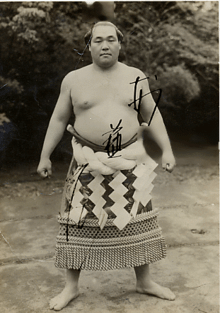Akinoumi Setsuo
| 安藝ノ海 節男 Akinoumi Setsuo | |
|---|---|
 | |
| Personal information | |
| Born |
Setsuo Nagata May 30, 1914 Hiroshima, Japan |
| Died | March 25, 1979 (aged 64) |
| Height | 1.77 m (5 ft 9 1⁄2 in) |
| Weight | 127.5 kg (281 lb) |
| Career | |
| Stable | Dewanoumi |
| Record | 209-101-38 |
| Debut | February 1932 |
| Highest rank | Yokozuna (May 1942) |
| Retired | November, 1946 |
| Championships |
1 (Makuuchi) 1 (Jonokuchi) |
| Gold Stars | 1 (Futabayama) |
| * Up to date as of August 2007. | |
Akinoumi Setsuo (安藝ノ海 節男, May 30, 1914 – March 25, 1979) was a sumo wrestler from Hiroshima, Japan. He was the sport's 37th yokozuna.
Career
Akinoumi made his professional debut in February 1932 and reached the top makuuchi division in January 1938. He was the man who ended Futabayama's record 69 bout winning streak in January 1939. As he was only ranked as a maegashira at the time, it was regarded as an enormous upset. He defeated the yokozuna by sotogake, an outer leg trip. His only top division championship came in May 1941 when he was ranked as a sekiwake. He earned promotion to yokozuna in May 1942 after two runner-up performances. Akinoumi was not a particularly successful yokozuna, lasting only eight tournaments at the rank and not managing to win any further championships. He is arguably better remembered for his victory over Futabayama than his exploits as a grand champion.[1]
He married the daughter of Dewanoumi Oyakata, the former yokozuna Tsunenohana, but was unfaithful to her, his geisha mistress giving birth the same day that his wife did.[1] They were later divorced.
Retirement from sumo
Akinoumi retired in November 1946, and became an elder of the Sumo Association with the name of Fujishima, but left the sumo world in January 1955.[2] He later remarried.
Top division record
- Through most of the 1930s and 1940s only two tournaments were held a year, and in 1946 only one was held.
| - | Spring Haru basho, Tokyo |
Summer Natsu basho, Tokyo |
Autumn Aki basho, Tokyo |
|||
|---|---|---|---|---|---|---|
| 1938 | West Maegashira #16
8–5 |
West Maegashira #10
9–4 |
Not held | |||
| 1939 | West Maegashira #3
6–7 ★ |
East Maegashira #4
10–5 |
Not held | |||
| 1940 | West Sekiwake
10–5 |
West Sekiwake
14–1 |
Not held | |||
| 1941 | East Ōzeki
12–3 |
East Ōzeki
9–6 |
Not held | |||
| 1942 | West Ōzeki
13–2 |
West Ōzeki
13–2 |
Not held | |||
| 1943 | East Yokozuna
12–3 |
West Yokozuna
11–4 |
Not held | |||
| 1944 | Sat out due to injury | West Yokozuna
5–5 |
Sat out due to injury | |||
| 1945 | Not held | East Yokozuna
6–1 |
East Yokozuna
4–6 |
|||
| 1946 | Not held | Not held | East Yokozuna
Retired 0–0–13 |
|||
| Record given as win-loss-absent Top Division Champion Retired Lower Divisions Key: ★=Kinboshi(s); d=Draw(s) (引分); h=Hold(s) (預り) | ||||||
See also
- Glossary of sumo terms
- List of past sumo wrestlers
- List of sumo tournament top division champions
- List of yokozuna
References
- 1 2 Sharnoff, Lora (1993). Grand Sumo. Weatherhill. ISBN 0-8348-0283-X.
- ↑ "Akinoumi Setsuo Kabu History". Sumo Reference. Retrieved 2012-10-06.
- ↑ "Akinoumi Setsuo Rikishi Information". Sumo References. Retrieved 2007-10-05.
External links
| Previous: Haguroyama Masaji |
37th Yokozuna 1941 - 1953 |
Next: Terukuni Manzō |
| Yokozuna is not a successive rank, and more than one wrestler can share the title | ||